
Jainism, also known as Jain Dharma, is an Indian religion. Jainism traces its spiritual ideas and history through the succession of twenty-four tirthankaras, with the first in the current time cycle being Rishabhadeva, whom the tradition holds to have lived millions of years ago, the twenty-third tirthankara Parshvanatha, whom historians date to the 9th century BCE, and the twenty-fourth tirthankara Mahavira, around 600 BCE. Jainism is considered an eternal dharma with the tirthankaras guiding every time cycle of the cosmology. Central to understanding Jain philosophy is the concept of bhedvigyān, or the clear distinction in the nature of the soul and non-soul entities. This principle underscores the innate purity and potential for liberation within every soul, distinct from the physical and mental elements that bind it to the cycle of birth and rebirth. Recognizing and internalizing this separation is essential for spiritual progress and the attainment of samyak darshan or self realization, which marks the beginning of the aspirant's journey towards liberation. The three main pillars of Jainism are ahiṃsā (non-violence), anekāntavāda (non-absolutism), and aparigraha (asceticism).

Mahavir Janma Kalyanak is one of the most important religious festivals in Jainism. It celebrates the birth of Mahavira, the twenty-fourth and last Tirthankara of present Avasarpiṇī. On the Gregorian calendar, the holiday occurs either in March or April.

The Śvetāmbara is one of the two main branches of Jainism, the other being the Digambara. Śvetāmbara in Sanskrit means "white-clad", and refers to its ascetics' practice of wearing white clothes, which sets it apart from the Digambara or "sky-clad" Jains whose ascetic practitioners go nude. Śvetāmbaras do not believe that ascetics must practice nudity.
Paryushana is an annual holy event for Jains and is usually celebrated in August, September or October in Hindi calendar Bhadrapad Month's Shukla Paksha. Jains increase their level of spiritual intensity often using fasting and prayer/meditation to help. The five main vows are emphasized during this time. There are no set rules, and followers are encouraged to practice according to their ability and desires. The event lasts for 8 or 10 days, and ends with the celebration of Samvatsari.

Acharya Vidyasagar was an influential Indian Digambara Jain acharya (monk), credited with having brought about a revival in educational and religious activities in Digambara Jainism. He wrote the epic Hindi poem Mukamati.
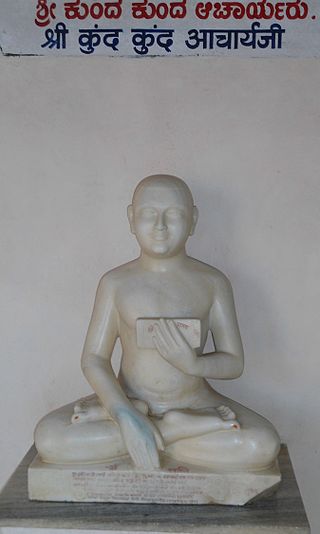
Jain monasticism refers to the order of monks and nuns in the Jain community and can be divided into two major denominations: the Digambara and the Śvētāmbara. The monastic practices of the two major sects vary greatly, but the major principles of both are identical. Five mahāvratas, from Mahavira's teachings, are followed by all Jain ascetics of both the sects. Historians believe that a united Jain sangha (community) existed before 367 BCE, about 160 years after the moksha (liberation) of Mahavira. The community then gradually divided into the major denominations. However, no evidences indicate when the schism between the Digambaras and the Śvetāmbaras happened.

Acharya Shri Shantisagar Ji (1872–1955) was an Indian Acharya of the Digambara monk faith. He was the first Acharya (preceptor) and a leader of his digamber sect in the 20th century. Shanti Sagar ji revived the teaching and practice of traditional Digambara practices in North India. He was lustrated as a kshullaka into the Sangha by Devappa (Devakirti) Swami Ji. He took his ailaka deeksha before an image of the Tirthankara Neminatha. In about 1920, Shantisagar Ji became a full muni (sadhu) of the Digambara. In 1922, at Yarnal village, Belgaum district, Karnataka, he was given the name "Shanti Sagar Ji".
Kumudendu Muni was a Digambara monk who authored Siribhoovalaya, a unique multi-lingual literary work. Scholars are divided about when he lived and not much is known about him. It is believed that he was the spiritual teacher of King Amoghavarsha and a disciple of Virasena and Jinasena. He is said to have lived around thousand years ago. Pandit Yellappa Shashtri was the first one to decipher his creation, Siribhoovalaya. Karlamangalam Srikantaiah, the editor of the first edition, claims that the work may have been composed around 800 AD.

Porwal, also known as Poravāḍa or Prāgvata, is a Kshatriya community that originated in southern Rajasthan, India. They are mainly of Jain or Hindu faith. The name Porwal was applied on the basis of the names of other Bania communities.

Jainism is a religion founded in ancient India. Jains trace their history through twenty-four tirthankara and revere Rishabhanatha as the first tirthankara. The last two tirthankara, the 23rd tirthankara Parshvanatha and the 24th tirthankara Mahavira are considered historical figures. According to Jain texts, the 22nd tirthankara Neminatha lived about 84,000 years ago and was the cousin of Krishna.

Digambara is one of the two major schools of Jainism, the other being Śvetāmbara (white-clad). The Sanskrit word Digambara means "sky-clad", referring to their traditional monastic practice of neither possessing nor wearing any clothes.

Jainism is an Indian religion which is traditionally believed to be propagated by twenty-four spiritual teachers known as tirthankara. Broadly, Jainism is divided into two major schools of thought, Digambara and Śvetāmbara. These are further divided into different sub-sects and traditions. While there are differences in practices, the core philosophy and main principles of each sect is the same.

Muni Tarun Sagar was an Indian Digambara monk. His lectures are termed Kadve Pravachan because they can be candidly critical of common practices and views. His lectures have been compiled and published in book series also titled Kadve Pravachan. Excerpts from his discourses are often published by newspapers. Unlike most other Digambar Jain monks, his audience often included a majority of non-Jains. His discourses often addressed family or society issues.
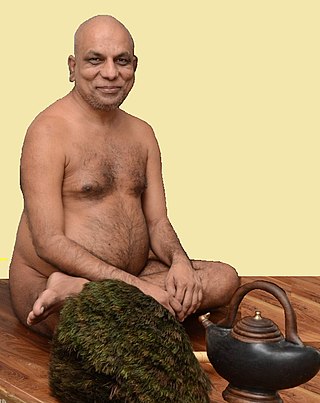
Munishri Pramansagarji Maharaj is a Digambar monk of Terapanth sub-sect. He is an able disciple of Acharya Shri Vidyasagar Ji Maharaj. He has set free the religion from traditional abstruseness and made it practicable in life. Through his sermons and initiatives, the process of a qualitative change in society has begun. He led a campaign to save the Jain tradition of Santhara also known as Sallekhana in the year 2015, in which millions of Jain community members took out massive silent rallies in several cities and towns all over the world against the Rajasthan High Court decision. Gunayatan is one of his important religious initiatives which is going to become a centre for self-development in the true sense. His pravachans and Shanka Samadhan programme are aired on Jinvani Channel and Paras TV Channel.
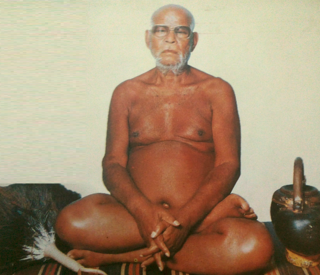
Acharya Deshbhushan was a Digambara Jain Acharya of 20th century who composed and translated many Kannada scriptures to Hindi and Sanskrit. He initiated and elevated several Jain monks and nuns like Shwetpichhi Acharya Vidyananda ji and Gyanmati Mataji. He is renowned for his remarkable translations of Kannada scriptures to Sanskrit and Hindi. He is the first Digambara Acharya to visit and address the Indian Parliament in the year 1974 along with the Prime Minister Indira Gandhi.
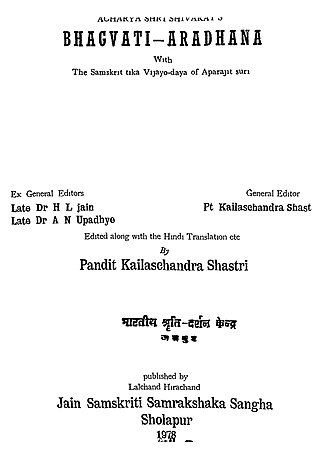
Aparajita was an eighth century Digambara monk.
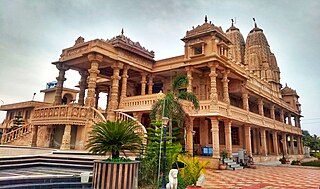
Upadhyaya Shri Guptisagarji is a Digambara monk who currently has the rank of an Upadhyaya. Born in 1957, he took ailak diksha under Acharya Vidyasagar ji in 1980, Muni diksha in 1982 also under Acharya Vidyasagar. He was initiated an Upadhyaya by Acharya Vidyanand ji in 1991. He is the inspiration behind Gupti Dham Jain Mandir, Ganaur, Sonipat.
Vidyananda was a Digambara logician, scholar and Jain monk in Pataliputra. He was born in 750 AD and died in 800. He wrote Ashtasahasri which is a commentary on Samantabhadra's Devagamastotra. Madhvacharya, a Hindu philosopher has mentioned Vidyananda. Another digambaraacharya with the same name flourished in the 20th-century India.
Sivabhuti was a Jain monk in the 1st century AD who is regarded as the founder of the Digambara tradition in 82 AD, according to the 5th-century Śvetāmbara text Avashyak Bhashya, written by Jinabhadra. Little is known about him apart from a single story mentioned in this ancient Śvetāmbara text. Among several works on Jainism, The Jains, a book by Paul Dundas, mentions him and the story. However, the historical authenticity of his existence or the truthfulness of the story has not been verified.

Antarikṣa Pārśvanātha Tīrtha is a Śvetāmbara Jain temple in Shirpur (Jain) town in Akola district, Maharashtra, India. Most popular for the main deity which is supposedly a 'floating' black-colored idol of Parshvanatha, the 23rd Tirthankara, this temple has been a center of devotion for Jains as well as of disputes between the Śvetāmbara and Digambara sect of Jainism. The main deity at this temple is one of the 108 most prominent idols of Pārśvanātha worshipped by Śvetāmbaras.















